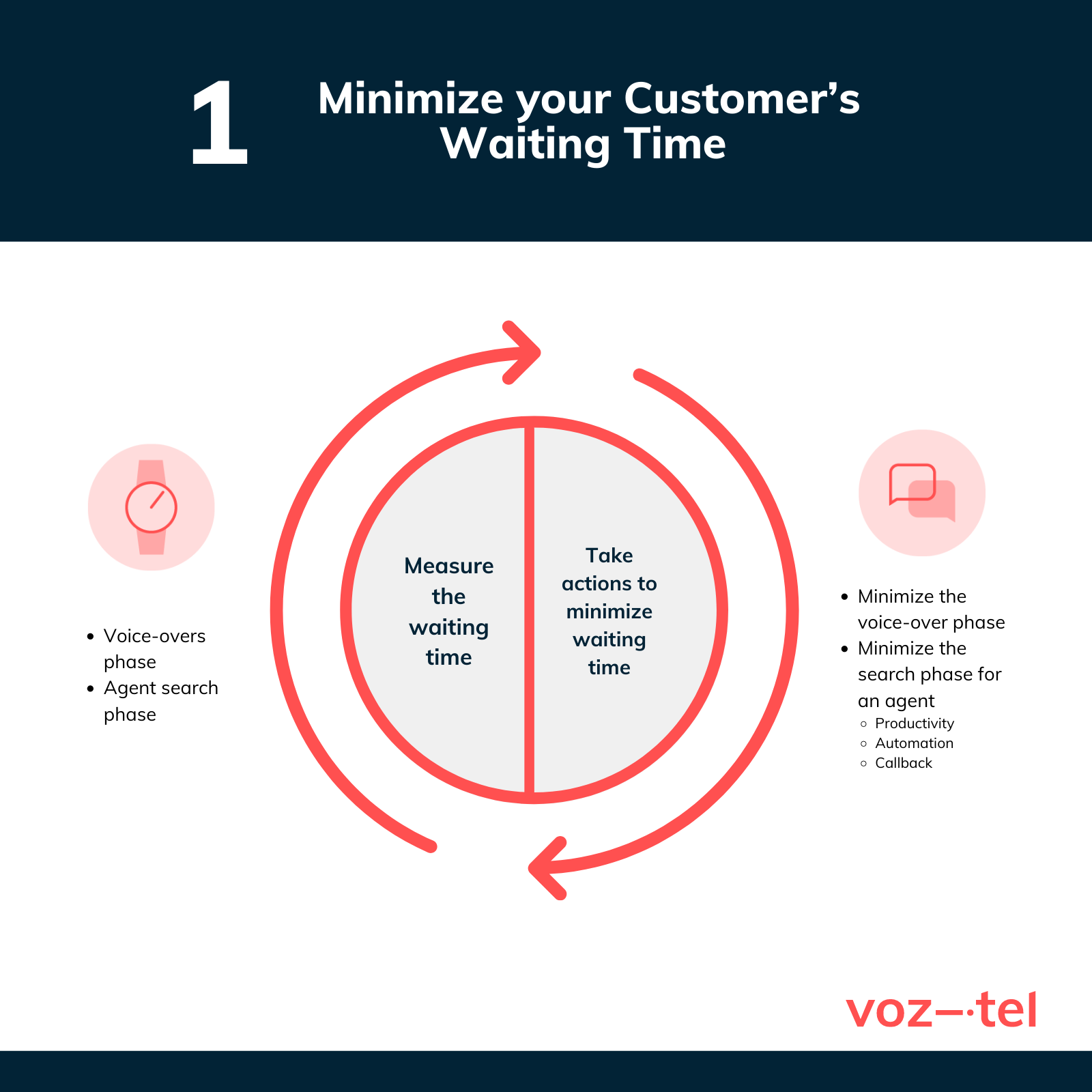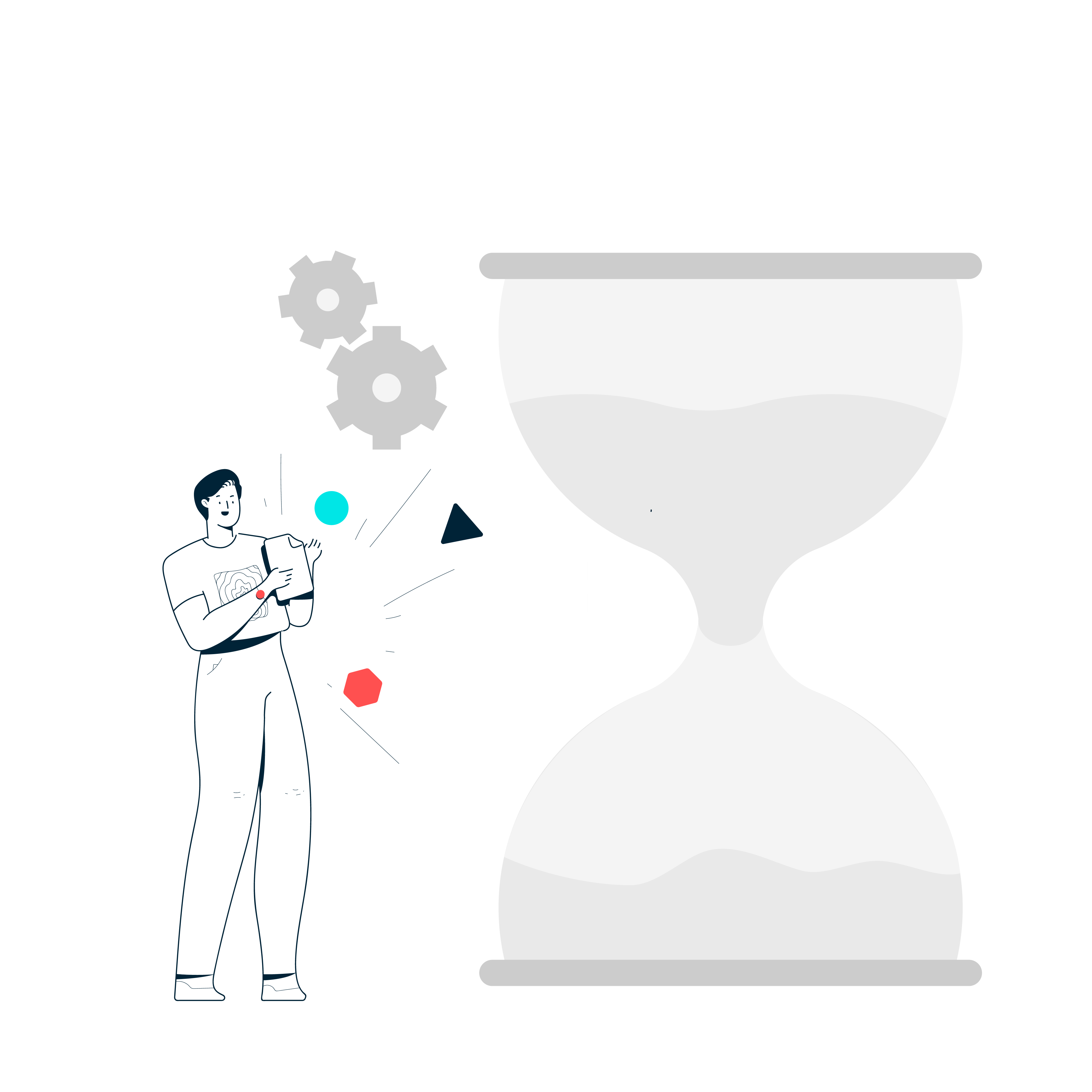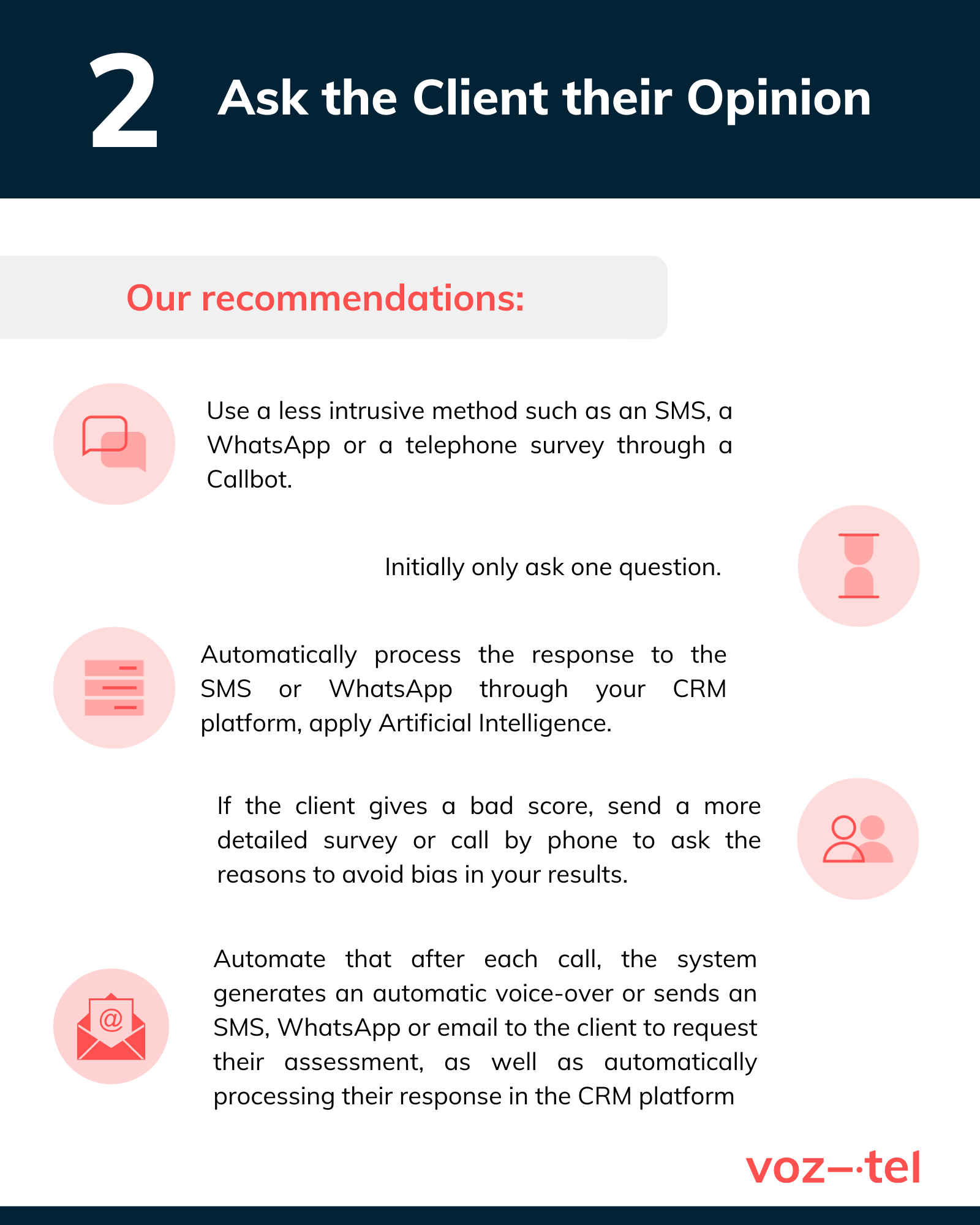2 functionalities that your Contact Center management system should allow you to apply to improve your quality policy.

In a scenario in which guaranteeing excellence in customer service is practically standard, it is necessary to implement a series of “checklists” or quality policies for your Contact Centre. It is therefore necessary for your Contact Centre management system to allow you to::
- Reduce the waiting time your customers spend on the phone before being attended to.
- While improving the quality of the service you offer.
1. Minimize your customer’s waiting time
This is the first sense of quality that the customer obtains and, therefore, the first factor on which you should focus your efforts. To do so, a cyclical process must be established:
- Measure the waiting time
- Take actions to minimize waiting time

Measure the waiting time
The waiting time is considered the time from when the customer calls until a person or an automated system – a Callbot – receives and answers their call.
The waiting time can be classified into two phases:
- Voice-overs phase: all the voice-overs that are shown to the client, IVRs that request data such as identity confirmations, etc.
- Agent search phase: the time between the end of the announcements and when an agent is available to answers the call.
Being able to accurately measure these waiting times is essential in proposing and carrying out actions to improve them, thus generating a better customer experience.
Take actions to minimize the waiting time
Once the waiting time has been identified, it is time to implement actions to minimize them. These are some of our recommendations:
SS| Minimise the voice-over phase
Are as many, long voice-overs really essential? This is the first question you need to ask yourself.
Although it is true that some are necessary because we do not have the technology to minimise them, we suggest you implement the following recommendations to improve the user experience in this phase:
- Avoid repetitive phrases: For example, if the system already knows that you have called the customer on previous occasions and the data protection clause has already been shown, do not show it again.
- Optimise management time: The customer could be identified by their telephone number. Therefore, do not ask for information that you already know, for example, their postcode, their ID card number, etc.
- Adapt your answer: If you already know that there are agents available at that time, show them the short version of the voice-overs. Otherwise, if there are no agents available at that time, show them the longer versions.
| Minimise the search phase for an agent: Productivity
The obvious solution for this is to hire more agents, but evidently although this is clearly not the optimal solution to improve your efficiency. To optimise this phase, data must be available that enables us to obtain the appropriate information when making decisions:
- Average time of agent conversations by type of queries (not including waiting times).
- Average afterwork time (time from when the agent finishes one call until the next one starts) by type of queries.
- Abandoned calls classified by customers and by time slot.
- Duration of waiting times for customers who have abandoned the call.
- Ratios of calls answered by agent and compared with the other agents.
- Dead time or when there are more agents than calls to attend to.
- Agent disconnection times and agent control.
- Downtime per agent, that is, you are not using the system and you are not talking to a customer when there are other people waiting to be served.

| Minimise the search phase for an agent: Automation
Are your agents doing tasks manually that could be automated? If they spend a lot of time doing repetitive tasks that are not necessary (because those tasks haven’t been automated), it will take longer for them to be available to take other calls with higher added value for the customer.
Some automations require the involvement of the IT department, but not all. Your Contact Centre management platform should allow you to autonomously:
- Generate response templates: email, WhatsApp, SMS, etc.
- Automatically create and send responses based on customer data (CRM) and available templates.
- Automatically insert data available in the CRM in external applications.
- Make queries to external applications with the data available in the CRM to avoid having to re-enter them.
- etc.
If you already know that the waiting time is long, ask the customer if they want to remain on hold or if they want to be called back automatically.
With a good CRM for Contact Centres, this process should be automatic and when an agent is available, the system calls the customer back and passes it on to the agent. In addition, it should allow you to prioritise the returning of this type of calls by different criteria, for example, the amount of debt or type of customer.
If you already know that the waiting time is long, ask the customer if they want to remain on hold or if they want to be called back automatically.
With a good CRM for Contact Centres, this process should be automatic and when an agent is available, the system calls the customer back and passes it on to the agent. In addition, it should allow you to prioritise the returning of this type of calls by different criteria, for example, the amount of debt or type of customer.
If you already know that the waiting time is long, ask the customer if they want to remain on hold or if they want to be called back automatically.
With a good CRM for Contact Centres, this process should be automatic and when an agent is available, the system calls the customer back and passes it on to the agent. In addition, it should allow you to prioritise the returning of this type of calls by different criteria, for example, the amount of debt or type of customer.
If you already know that the waiting time is long, ask the customer if they want to remain on hold or if they want to be called back automatically.
With a good CRM for Contact Centres, this process should be automatic and when an agent is available, the system calls the customer back and passes it on to the agent. In addition, it should allow you to prioritise the returning of this type of calls by different criteria, for example, the amount of debt or type of customer.
If you already know that the waiting time is long, ask the customer if they want to remain on hold or if they want to be called back automatically.
With a good CRM for Contact Centres, this process should be automatic and when an agent is available, the system calls the customer back and passes it on to the agent. In addition, it should allow you to prioritise the returning of this type of calls by different criteria, for example, the amount of debt or type of customer.
If you already know that the waiting time is long, ask the customer if they want to remain on hold or if they want to be called back automatically.
With a good CRM for Contact Centres, this process should be automatic and when an agent is available, the system calls the customer back and passes it on to the agent. In addition, it should allow you to prioritise the returning of this type of calls by different criteria, for example, the amount of debt or type of customer.
If you already know that the waiting time is long, ask the customer if they want to remain on hold or if they want to be called back automatically.
With a good CRM for Contact Centres, this process should be automatic and when an agent is available, the system calls the customer back and passes it on to the agent. In addition, it should allow you to prioritise the returning of this type of calls by different criteria, for example, the amount of debt or type of customer.
If you already know that the waiting time is long, ask the customer if they want to remain on hold or if they want to be called back automatically.
With a good CRM for Contact Centres, this process should be automatic and when an agent is available, the system calls the customer back and passes it on to the agent. In addition, it should allow you to prioritise the returning of this type of calls by different criteria, for example, the amount of debt or type of customer.
Do agents do repetitive and simple tasks? A Callbot could do them automatically:
- Manage collections and process payments (by credit card)
- Generate support tickets.
- Check order status.
- Verify personal data.
- Arrange appointments.
- Conduct surveys and forms.
- Request forwarding of documents: invoices, etc.
If you are concerned about the reaction of your customers when interacting with a virtual agent for the first time, there are ways to customise and adjust the attention of the Callbots for gradual implementation. For example, you can ensure it is only activated if the average waiting time exceeds a certain value, and offer the customer the option of being attended by a Callbot if they do not wish to keep waiting.
| Minimise the search phase for an agent: Callback
If you already know that the waiting time is long, ask the customer if they want to remain on hold or if they want to be called back automatically.
With a good CRM for Contact Centres, this process should be automatic and when an agent is available, the system calls the customer back and passes it on to the agent. In addition, it should allow you to prioritise the returning of this type of calls by different criteria, for example, the amount of debt or type of customer.
2. Ask the client for their opinion
While it is important to know the opinion of our customers, you should be cautious because they probably do not want to spend too much time answering surveys. Therefore, it is preferable to ask fewer questions and ensure they answer all of them.
But the issue now is, how many questions are appropriate? From our experience, we can suggest that two questions guarantee a higher response rate.
Moreover, bear in mind that it is very likely that the customers who are most willing to invest their time answering a survey will be those with a negative perception, which would cause a bias in the results if the variables are not modified for these types of customers.
Our recommendation is as follows:
- Use a less intrusive method such as an SMS, a WhatsApp or a telephone survey through a Callbot.
- Ask only one question initially, for example: “Rate the quality of our service from 0 to 10”
- Automatically process the response to the SMS or WhatsApp through your CRM platform, apply Artificial Intelligence and act accordingly.
- If the customer gives a poor score, send a more detailed survey or phone them to ask the reasons to avoid bias in your results.

-
- Automate the system so that, after each call, it generates an automatic voice-over or sends an SMS, WhatsApp or email to the customer to request their assessment, as well as automatically processing their response in the CRM platform.
In addition, your Contact Centre management system should also allow you to:
- Conduct tabulated surveys through an email with a link to a website.
- Have a Callbot make the call and implement the survey.
- Generate an automated call for a quality control agent to call the customer if the assessment provided is not good.

Main Conclusions
In this article, we have seen how to make the most of your Contact Centre through an analysis of the factors that may be lowering the quality of the service you offer.
However, applying these recommendations is not enough and, to a large extent, these optimisations can only exist when you have a CRM platform at your disposal that allows you to perform all these functionalities in an optimal, efficient way.
At Vozitel we offer (in a single platform) the necessary tools to manage and optimise the capacity and quality of your Contact Centre in an easy, efficient and intuitive way. For more information.
